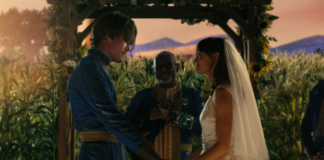Knockout City‘s days are numbered, but for Velan Studios, there’s still a strong sense of optimism. Though the live-service PvP dodgeball game nears its second anniversary on May 21, it’ll only exist in its current state for another few weeks beyond that. In a February blog post, Velan revealed that Knockout City will be taken offline on June 6, with the silver-lining exception being that Velan will enable private servers to be hosted on PC thereafter.
The news came as the latest in a series of live-service game closures that defined January 2023, and looking back a few years proves this was no one-month trend. It’s getting harder to stay afloat in the competitive and ever-changing world of live-service video games. As Knockout City is a personal favorite of mine, the news hit me like, well, a dodgeball to the face. I wanted to speak to the team to find out what it’s like when a game you love working on is ending on the market’s terms rather than your own. Though those I spoke to admitted there is a sadness to the situation, they weren’t without hope for what’s next, both within Velan and across the industry–even if it’ll take a paradigm shift to get things where they need to be.
“This is my favorite game I’ve ever worked on,” game director Jeremy Russo told me. “And it’s also one of my favorite games I’ve ever played. Like, I still play this. And if you talk to most developers, none of them play their own game. But I still have a blast logging in and playing with my friends, grouping up, and going into these brawls.”
Russo explained how the six years on Knockout City were remarkably formative for the studio, which was established in 2016 and has otherwise developed augmented reality racing games like Mario Kart Live Home Circuit and the upcoming Hot Wheels Rift Rally. “We built the team, we built an engine, we built this entire game experience, we released it […] Running a live-ops experience was the first time a lot of us had ever done that even though we’ve been in the industry for a long time. And so what we did accomplish in terms of the critical praise we had at launch and the ridiculously adoring community that we have, it’s tough to feel anything other than that this was successful and to think of the pride that I have in the team and in the game itself.”
There were a few words that came up a lot in my 40-minute chat with Russo, CEO Karthik Bala, and marketing director Josh Harrison. “Pride” was one of them. “Analytics” was another.
“It really depends on what it is that we’re trying to improve at that given time,” Russo told me when I asked what Velan’s live-ops analytics actually investigate. “Are we looking at, you know, concurrency? Retention? Monetization? Like what are we actually testing with this new idea? And then we’ll add analytics for that specific topic. And we’ll kind of laser in on that. And a lot of us were figuring that out as we went along and discovered, ‘Okay, we think we have a problem here, let’s add some data to try to verify that. Okay, now let’s try to add a new feature or change a feature to try to improve that number.'”
If it sounds unclear, I’d agree. For live-service games especially, analytics are a vital compass for studios. You have to amass data, find the weaknesses to improve on or strengths to further solidify, then tweak the game and see how these data points change. When things are pointing in the right direction–players are playing a lot at once, they’re returning to play often, they’re spending in-game currency–your live-service game is probably doing well. But when the numbers suggest trouble ahead, it can be hard to pivot, because attribution can be hazy.
Did players disengage because of a change you made to your game, or because of something external, such as another game launching or becoming the next big thing on Twitch? There’s a variety of factors at play, making the science of measuring success unclear. Even clear-headed pivots take time and resources from other areas–especially on an indie team like this one.
“There’s no autopilot,” Bala said. “And when we’re looking at feedback from the community and things that are needed, there’s a set of leads that are on the project, [like] Jeremy, we have lead engineers and artists and physics–the core braintrust. And so if we’re trying to retool, that small core creative team and technical team is needed to be able to do that. But it’s that same team that’s running the day-to-day, you know, and there isn’t this large powerhouse of people somewhere maintaining and running the game.”
I love Knockout City, and I’d play it even if the cycle of new Brawl Passes and in-game events were absent for what Velan might say is a retooling period of months or even a year. But that’s my point of view as a fan who is already heavily invested. In reality, “the internet is not static,” as Bala explained, and the team needed to both retool the game in foundational ways while also keeping the major content beats intact if they wanted to keep most players coming back.
“It did come down to metrics,” Bala told me. “Being able to have the retention of players. We had a strong core community, but a lot of people who really enjoyed the game kind of [just] came through. They may go away for a while, they may come back, but the overall retention rate–which is critical to the heartbeat of any kind of live-service game–has to be at a certain level, month-to-month, to make it make sense. Otherwise, you know, you’re not able to create a sustainable business to keep going. And that’s the cold, hard reality that we had to face, which makes this really hard and really emotional.”
In a market that can turn on a dime–remember Fortnite’s almost overnight usurping of PUBG’s throne?–the volatility of the live-service world as both a fight for your money and time makes developing in this space incredibly difficult. Despite over 12 million players since launch, Knockout City joins countless other games that struggled to find a happy medium. It wasn’t the biggest game in the world, but neither were its lobbies empty. I’ve played other games where, at the end of their days, you find yourself queuing up with the same 6-10 others because you’re literally the last players in the community (RIP Onrush).
From the outside, Knockout City was doing much better than that, but it was also far from the Fortnite tier. And currently it feels scary as a player–and surely as a developer, too–to see game preservation on both macro and micro levels in doubt going forward. If great games like Knockout City can’t achieve stability and are nearly scrubbed from history, is there a future in live-service games that isn’t all or nothing?
Answering that question reveals a “painful truth,” said Bala, but he likened a way out of it similar to when we saw the rise of breakout indie games that could find success in a sea of gargantuan triple-A games. “The free-to-play business, if you’re not at scale, is really, really tough. You know, we went from games that could be multiplayer-only and be mid-price premium to, for multiplayer-only, you have to be free-to-play to be able to get a global scale. And if you don’t get escape velocity, it’s really hard to keep the lights on.
“And I think the industry is going to evolve from this. There’s going to be new models. I don’t think the players are going to stay satisfied with just the massive games that are dominating, and you’re gonna get some breakout stuff under new business models, and you know that players are going to enjoy it. I don’t think we’re there yet, personally, but I think this is also the exciting part for us, because we do have ideas of where it can go.”
For Bala, he envisions a meeting of the minds ahead. “I think that we’re not the only studio in this particular boat, you know? And there’s GDC coming up, the DICE conference coming up[…] Because it’s kind of a hot topic amongst our peer group, we’re going to be particularly talking a lot about it.”
“I don’t think we know the answer yet,” Russo added. “I think it’s an industry-wide thing that needs to happen. The industry needs to figure this out. Like, that example of indie single-player games, how they kind of figured out a different approach to creating quality content. For multiplayer-focused indie games, I think that’s the next big business model to figure out so that it can be sustainable right away from the start with small audiences, experimental game features.”
The conversation was certainly bittersweet. It’s clear, in the best-case scenario, Knockout City would’ve continued for longer. But still, Harrison said that the game has been such a vital learning experience for everyone that better days are ahead. “This is the end of this chapter of Knockout City, but this may not be the end of Knockout City in general,” he said, referring to what the team has publicly called the Knockout City universe.
“We’re not looking back at this franchise and saying like, ‘Hey, this IP isn’t that great.’ We love Knockout City. If we can solve some of these challenges, there’s a world where we may bring it back. There’s a world where we may look at a different element of this IP. And even if neither of those things happen, we’ve still learned so much from this, that whatever we make next is going to take cues from everything that we’ve learned here and be better because of it. We have teams working on really exciting prototyping projects that are only possible because of what we’ve done here. And it’s hard not to look at that in a positive light.”
For more on Knockout City’s final days ahead, and how the team has enabled the game to love on in some way after June 6, check out this recent blog post.



















